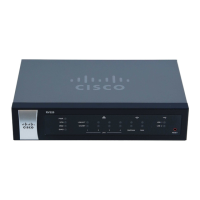System Management
LLDP Properties
62 Cisco RV320/RV325 Administration Guide
5
LLDP Properties
Link Layer Discovery Protocol (LLDP) is a vendor-neutral protocol in the Internet
Protocol Suite used by network devices for advertising their identity, capabilities,
and neighbors on an IEEE 802 local area network, principally wired Ethernet. LLDP
information is sent by devices from each of their interfaces at a fixed interval, in the
form of an Ethernet frame. Each frame contains one LLDP Data Unit (LLDPDU). Each
LLDPDU is a sequence of type-length-value (TLV) structures.
To enable LLDP Properties, check the Enable box. (It is enabled by default.)
To enable LLDP Properties on an interface, check the Enable, WAN1 or WAN2
box. (They are enabled by default.)
The LLDP Neighbor table displays this information:
• Local Port—Port identifier.
• ChassisID Subtype—Type of chassis ID (for example, MAC address).
• ChassisID—Identifier of the chassis. Where the chassis ID subtype is a
MAC address, the MAC address of the device is displayed.
• Port ID Subtype—Type of the port identifier.
• Port ID—Port identifier.
• System Name—Name of the device.
• Time to Live—Rate in seconds at which LLDP advertisement updates are
sent.
Using Diagnostics
The Diagnostic page accesses two built-in tools, DNS Name Lookup and Ping. If
you suspect a problem with connectivity, you can use these tools to investigate
the cause.
To use DNS to learn an IP address, choose DNS Lookup, enter the Lookup
Domain Name , such as www.cisco.com, and click Go. The IP address is
displayed.

